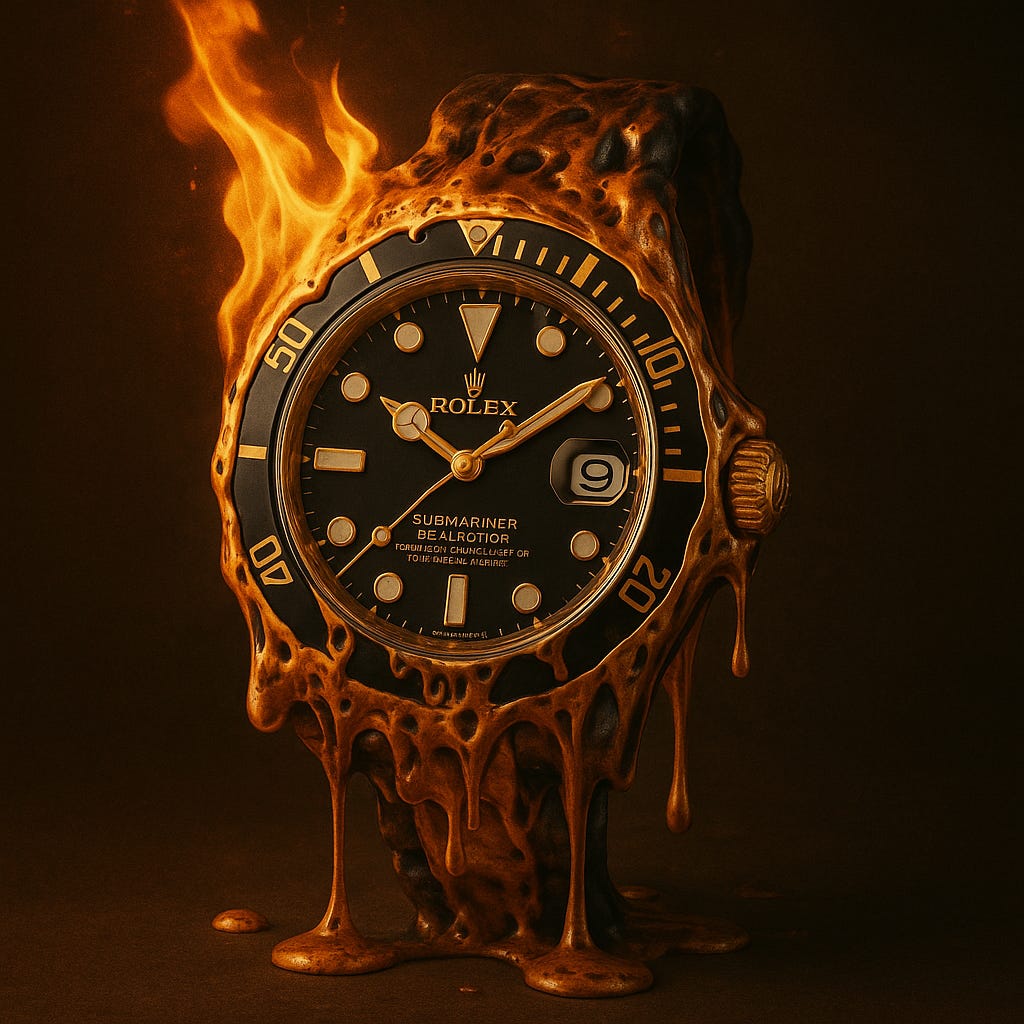Nobody Buys a Rolex to Tell the Time
Branding lessons straight from luxury’s playbook
A Conversation in Johannesburg
A couple of weeks ago, I was in Johannesburg, cooling off after a meeting in the hotel library. A painting caught my eye. As I stood there, a few strangers wandered in, drawn to it too. We started chatting about the painting. We were trying to figure out how such an abstract painting commands such a high price. Who decide its value? Then one guy drops a line out of nowhere:
“It’s like watches—nobody buys a watch to tell the time.”
It landed. At first, it sounds like casual banter. But if you unpack it, that one sentence carries the whole logic of branding. Think about it: if telling the time was the real goal, you’d grab a Casio for R500 and be done. Yet people spend R500,000 on a Rolex. Why? Because they’re not buying a timepiece. They’re buying what that watch says about them.
That’s branding in its rawest form. Function matters, but only as a baseline. The real reason people pay a premium is because the product has become a symbol. It communicates identity, status, and story, without a single word being said.
Why Start With Luxury?
This post is Part One in a bigger series on branding. And I’m starting with luxury and niche goods for a simple reason: they strip the mechanics bare.
In these markets, branding isn’t just a nice-to-have. Branding is the product. Nobody buys a Hermès Birkin bag for the quality of the leather alone. They buy it because carrying it tells a story, to the world and to themselves.
Luxury makes the invisible visible. Once you understand how branding drives meaning here, you’ll see the same rules everywhere, whether you’re selling cloud software, financial services, or artisanal coffee.
Branding vs. Marketing
Here’s where many people get confused. Marketing and branding aren’t interchangeable.
Marketing is the megaphone. It shouts louder, builds awareness, drives demand.
Brand is the invisible layer wrapped around the product. It’s the bundle of meaning, identity, and recognition that comes with it.
That’s why luxury brands pour money not only into ads, but into protecting their meaning. They guard every touchpoint, the logo, the packaging, the celebrity who wears it, because the brand is what people are buying.
Here’s the blunt truth: if nobody recognises the logo on your wrist, the premium vanishes. You might still have fine Swiss engineering, but without recognition and resonance, it’s just steel and gears. The true value of brand lies in social meaning and narrative.
Lessons From Luxury
1. Specialisation Builds Trust
Luxury brands often start hyper-focused. Think of Rolex, originally making waterproof dive watches, or Louboutin, focused on a single kind of shoe. They didn’t try to be everything for everyone. They nailed one thing with precision.
That narrowness builds depth. It tells customers: “We know this space better than anyone.” And once trust is built in that niche, the brand can expand. The same works in B2B. HubSpot started as “the inbound marketing guys.” Only later did they branch into sales, service, and CRM.
2. Emotions Beat Logic
Nobody needs a Ferrari. They want a Ferrari because of how it makes them feel. Pride, aspiration, belonging; that’s the real currency.
And this is universal. Apple doesn’t just sell hardware. They sell the feeling of being creative, innovative, part of a tribe that “thinks different.” Patagonia doesn’t just sell jackets. They sell a sense of environmental responsibility and moral high ground.
Logic convinces people to try. Emotion convinces people to stay.
3. Subtlety Signals Confidence
Ever noticed the trend of “quiet luxury”? The brands with no loud logos, just subtle cues, like the exact shade of Bottega green or the cut of a Loro Piana coat. It’s a flex precisely because it doesn’t shout.
In business software, the same principle applies. Think about Slack’s design: simple, understated, but instantly recognisable. Confidence often comes from simplicity, not from screaming for attention.
4. Authenticity Justifies the Price
When a brand shows its craft, heritage, artisans, sustainability, it gives buyers a reason to pay more. A Birkenstock made in Germany feels different from a no-name sandal, not just because of comfort, but because of the story of craft.
In tech, Basecamp has built trust by openly talking about their process, values, and philosophy. They’re not just selling project management software; they’re selling a worldview.
5. Niche Is a Launchpad, Not a Limit
Starting in a niche isn’t a cage. It’s a lab. You refine your identity, message, and value proposition in a tight space where signals are clear.
Nike began with running shoes for athletes. Only later did they become a global lifestyle empire. The same principle applies to any business: start focused, prove your resonance, then scale authenticity into bigger markets.
The Big Picture
So what does this all mean?
It means branding is not window dressing. It’s not the “polish” you slap on after the product is built. Branding is identity, packaged. The shirt is just cotton, but the Gucci logo turns it into a statement. Salesforce isn’t just software, it’s a signal that you’re a “serious” business player.
Once product quality becomes table stakes (and in most industries it already has), brand becomes the differentiator. Customers take home more than an object or a service. They take home a story.
Where We Go Next
This series will unpack branding step by step. Starting with luxury gives us a clean lens, but the real goal is to show how these principles apply everywhere, even in spaces far removed from luxury.
So ask yourself: when you pick a brand, what are you really buying? And if you’re building a brand, what do you want your buyers to feel they’re taking home?
Make it rAIn,
KG



